Development of a Novel Interactive Multimedia E-Learning Model to Enhance Clinical Competency Training and Quality of Care among Medical Students
Abstract
1. Introduction
2. Materials and Methods
2.1. Study Design and Participants
2.2. Data Collection
2.3. Data Analysis
3. Results
4. Discussion
5. Conclusions
Author Contributions
Funding
Acknowledgments
Conflicts of Interest
References
- Stevens, D.P. Finding safety in medical education. Qual. Saf. Health Care 2002, 11, 109–110. [Google Scholar] [CrossRef]
- Ruiz, J.G.; Mintzer, M.J.; Leipzig, R.M. The impact of E-learning in medical education. Acad. Med. 2006, 81, 207–212. [Google Scholar] [CrossRef] [PubMed]
- Warriner, D.R.; Bayley, M.; Shi, Y.; Lawford, P.V.; Narracott, A.; Fenner, J. Computer model for the cardiovascular system: Development of an e-learning tool for teaching of medical students. BMC Med. Educ. 2017, 17, 220. [Google Scholar] [CrossRef] [PubMed]
- Fransen, F.; Martens, H.; Nagtzaam, I.; Heeneman, S. Use of e-learning in clinical clerkships: Effects on acquisition of dermatological knowledge and learning processes. Int. J. Med. Educ. 2018, 9, 11–17. [Google Scholar] [CrossRef] [PubMed]
- Khasawneh, R.; Simonsen, K.; Snowden, J.; Higgins, J.; Beck, G. The effectiveness of e-learning in pediatric medical student education. Med. Educ. Online 2016, 21, 29516. [Google Scholar] [CrossRef]
- Kim, K.J.; Kang, Y.; Kim, G. The gap between medical faculty’s perceptions and use of e-learning resources. Med. Educ. Online 2017, 22, 1338504. [Google Scholar] [CrossRef]
- Jang, H.W.; Kim, K.J. Use of online clinical videos for clinical skills training for medical students: Benefits and challenges. BMC Med. Educ. 2014, 14, 56. [Google Scholar] [CrossRef]
- Liu, M.; Huang, Y.S.; Liu, K.M. Assessing core clinical competencies required of medical graduates in Taiwan. Kaohsiung J. Med. Sci. 2006, 22, 475–483. [Google Scholar] [CrossRef]
- Wang, Y.A.; Chen, C.F.; Chen, C.H.; Wang, G.L.; Huang, A.T. A clinical clerkship collaborative program in Taiwan: Acquiring core clinical competencies through patient care responsibility. J. Formos. Med. Assoc. 2016, 115, 418–425. [Google Scholar] [CrossRef][Green Version]
- Chan, W.P.; Wu, T.Y.; Hsieh, M.S.; Chou, T.Y.; Wong, C.S.; Fang, J.T.; Chang, N.C.; Hong, C.Y.; Tzeng, C.R. Students’ view upon graduation: A survey of medical education in Taiwan. BMC Med. Educ. 2012, 12, 127. [Google Scholar] [CrossRef]
- Turner, J.L.; Dankoski, M.E. Objective structured clinical exams: A critical review. Fam. Med. 2008, 40, 574–578. [Google Scholar] [PubMed]
- Grand’Maison, P.; Lescop, J.; Rainsberry, P.; Brailovsky, C.A. Large-scale use of an objective, structured clinical examination for licensing family physicians. CMAJ 1992, 146, 1735–1740. [Google Scholar] [PubMed]
- Ekenze, S.O.; Okafor, C.I.; Ekenze, O.S.; Nwosu, J.N.; Ezepue, U.F. The Value of Internet Tools in Undergraduate Surgical Education: Perspective of Medical Students in a Developing Country. World J. Surg. 2017, 41, 672–680. [Google Scholar] [CrossRef] [PubMed]
- Clark, D. Psychological myths in e-learning. Med. Teach. 2002, 24, 598–604. [Google Scholar] [CrossRef]
- Cook, D.A.; Garside, S.; Levinson, A.J.; Dupras, D.M.; Montori, V.M. What do we mean by web-based learning? A systematic review of the variability of interventions. Med. Educ. 2010, 44, 765–774. [Google Scholar] [CrossRef]
- Chodorow, S. Educators must take the electronic revolution seriously. Acad. Med. 1996, 71, 221–226. [Google Scholar] [CrossRef]
- Fontaine, G.; Cossette, S.; Maheu-Cadotte, M.A.; Mailhot, T.; Deschenes, M.F.; Mathieu-Dupuis, G. Effectiveness of Adaptive E-Learning Environments on Knowledge, Competence, and Behavior in Health Professionals and Students: Protocol for a Systematic Review and Meta-Analysis. JMIR Res. Protoc. 2017, 6, e128. [Google Scholar] [CrossRef]
- Muttappallymyalil, J.; Mendis, S.; John, L.J.; Shanthakumari, N.; Sreedharan, J.; Shaikh, R.B. Evolution of technology in teaching: Blackboard and beyond in Medical Education. Nepal J. Epidemiol. 2016, 6, 588–592. [Google Scholar] [CrossRef]
- Choules, A.P. The use of elearning in medical education: A review of the current situation. Postgrad. Med. J. 2007, 83, 212–216. [Google Scholar] [CrossRef]
- Hsiao, C.C.; Tiao, M.M.; Chen, C.C. Using interactive multimedia e-Books for learning blood cell morphology in pediatric hematology. BMC Med. Educ. 2016, 16, 290. [Google Scholar] [CrossRef]
- Kirkpatrick, D.L.; Kirkpatrick, J.D. Evaluating Training Programs: The Four Levels, 3rd ed.; Berrett-Koehler Publishers: San Francisco, CA, USA, 2012. [Google Scholar]
- Colt, H.G.; Davoudi, M.; Murgu, S.; Zamanian Rohani, N. Measuring learning gain during a one-day introductory bronchoscopy course. Surg. Endosc. 2011, 25, 207–216. [Google Scholar] [CrossRef] [PubMed]
- Sinclair, P.; Kable, A.; Levett-Jones, T. The effectiveness of internet-based e-learning on clinician behavior and patient outcomes: A systematic review protocol. JBI Database Syst. Rev. Implement. Rep. 2015, 13, 52–64. [Google Scholar] [CrossRef] [PubMed]
- Richmond, H.; Copsey, B.; Hall, A.M.; Davies, D.; Lamb, S.E. A systematic review and meta-analysis of online versus alternative methods for training licensed health care professionals to deliver clinical interventions. BMC Med. Educ. 2017, 17, 227. [Google Scholar] [CrossRef] [PubMed]
- Singh, A.; Min, A.K. Digital lectures for learning gross anatomy: A study of their efficacy. Korean J. Med. Educ. 2017, 29, 27–32. [Google Scholar] [CrossRef] [PubMed]
- Mohr, J.J.; Batalden, P.B. Improving safety on the front lines: The role of clinical microsystems. Qual. Saf. Health Care 2002, 11, 45–50. [Google Scholar] [CrossRef] [PubMed]
- Lin, Y.K.; Chen, D.Y.; Lin, B.Y. Determinants and effects of medical students’ core self-evaluation tendencies on clinical competence and workplace well-being in clerkship. PLoS ONE 2017, 12, e0188651. [Google Scholar] [CrossRef]
- Lien, H.H.; Hsu, S.F.; Chen, S.C.; Yeh, J.H. Can teaching hospitals use serial formative OSCEs to improve student performance? BMC Res. Notes 2016, 9, 464. [Google Scholar] [CrossRef]
- Gibbons, A.S.; Fairweather, P.G. Computer-based instruction. In Training & Retraining: A Handbook for Business, Industry, Government, and the Military; Tobias, S., Fletcher, J.D., Eds.; Macmillan Library Reference: New York, NY, USA, 2000; pp. 410–442. [Google Scholar]
- Looi, C.-K.; Seow, P.; Zhang, B.; So, H.-J.; Chen, W.; Wong, L.-H. Leveraging mobile technology for sustainable seamless learning: A research agenda. Br. J. Educ. Technol. 2010, 41, 154–169. [Google Scholar] [CrossRef]
- Pottle, J. Virtual reality and the transformation of medical education. Future Healthc. J. 2019, 6, 181–185. [Google Scholar] [CrossRef]
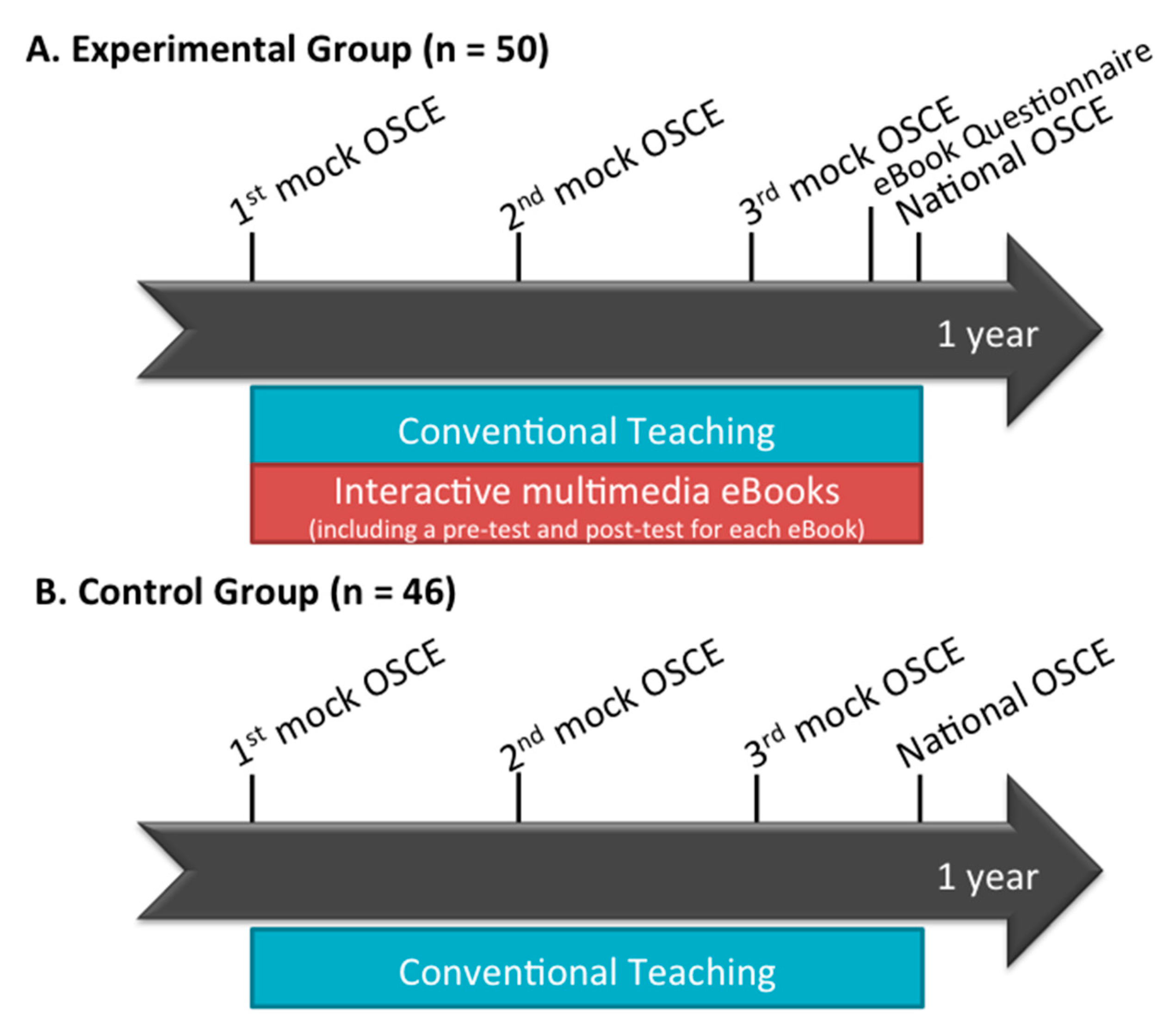

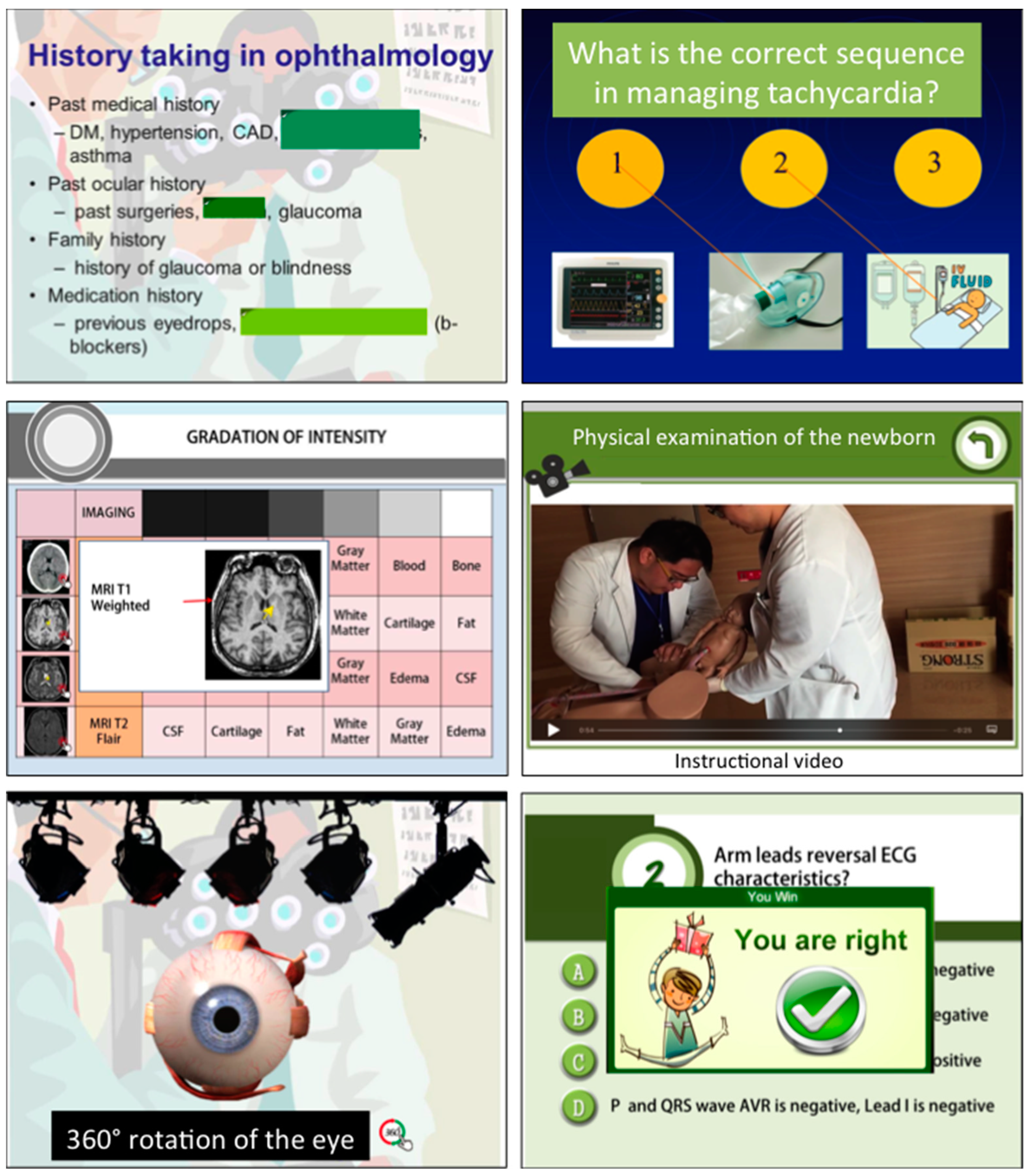
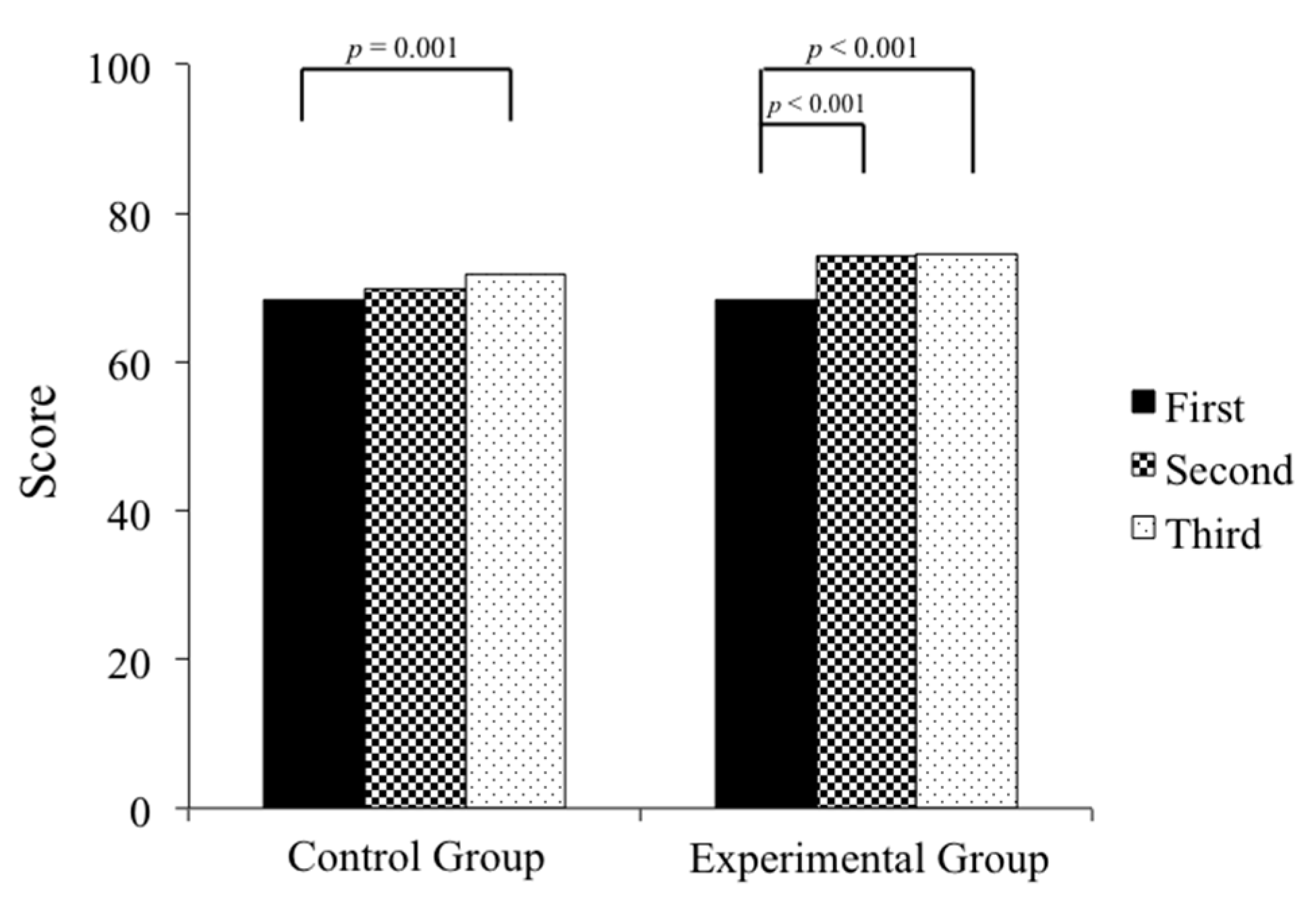
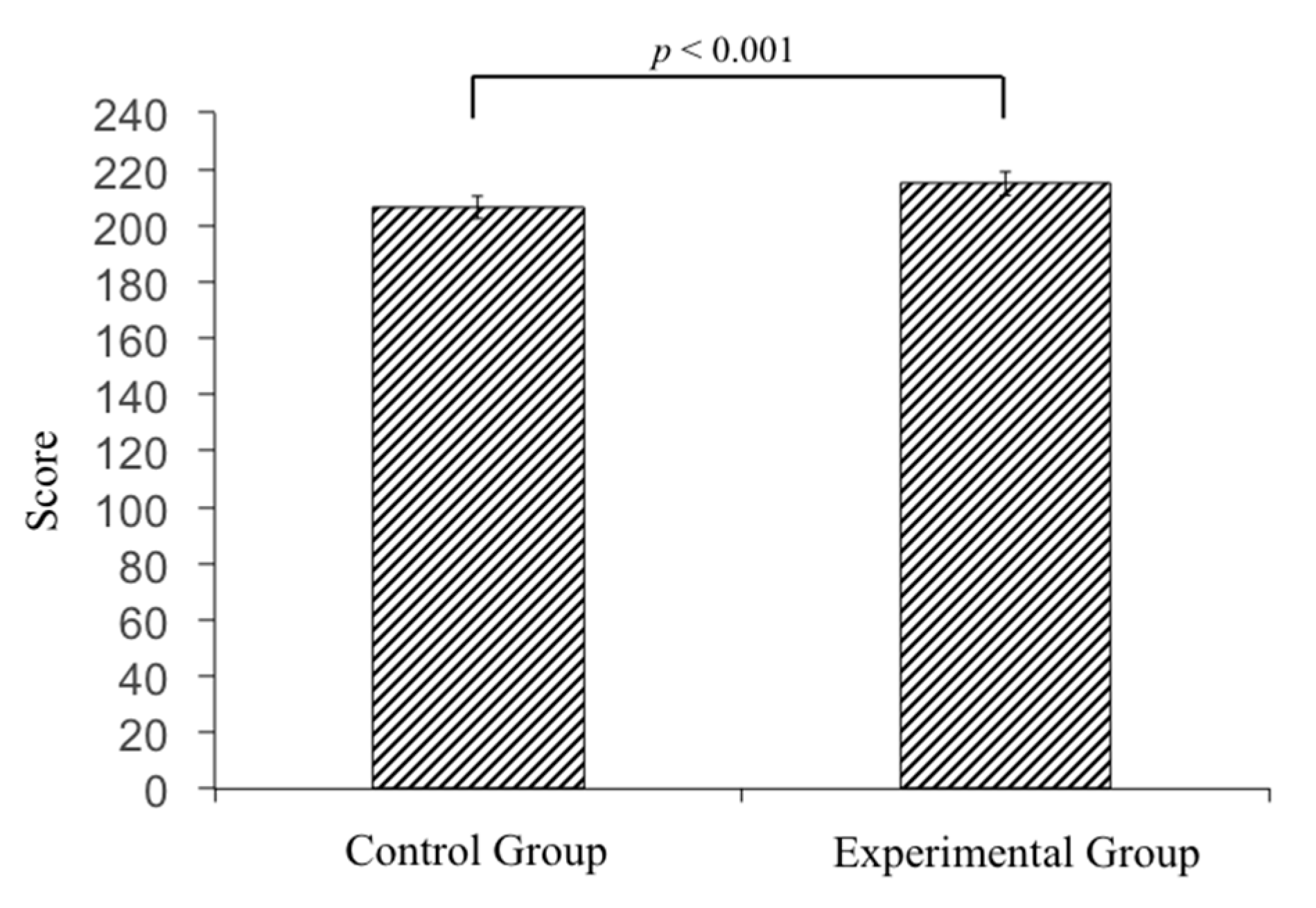
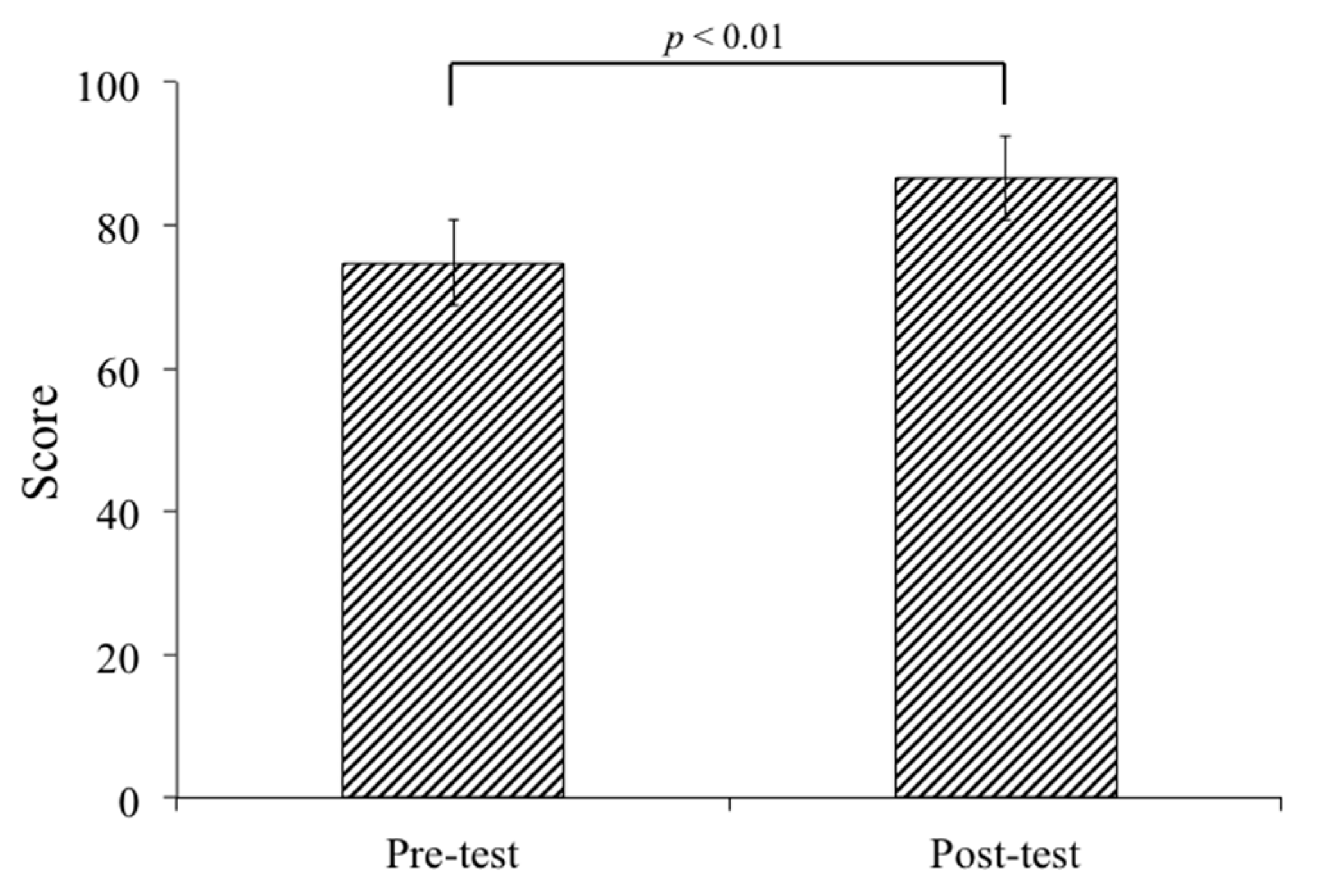
| Mean Scores | p Value | |
|---|---|---|
| Control group | 0.006 | |
| First | 68.26 ± 6.06 | |
| Second | 69.74 ± 4.57 | |
| Third | 71.78 ± 4.79 | |
| Experimental group | <0.001 | |
| First | 68.30 ± 6.40 | |
| Second | 74.14 ± 5.47 | |
| Third | 74.60 ± 6.99 |
| No. | Questionnaire | Average Rating |
|---|---|---|
| 1 | Interactive materials improve my learning efficiency | 4.22/agree |
| 2 | Interactive materials can improve the retention of knowledge | 4.23/agree |
| 3 | Interactive materials increase my focus in learning | 4.03/agree |
| 4 | Interactive materials enhance learning motivations | 4.12/agree |
| 5 | Teaching materials improve my ability in solving problems | 4.09/agree |
| 6 | The teaching material helps to improve my clinical skills | 4.22/agree |
| 7 | The teaching material improves my ability in making appropriate treatment decisions based upon patients’ needs | 4.22/agree |
| 8 | eBooks increase my interest in dealing with clinical competency aspects of patient care | 4.20/agree |
| Overall average | 4.17/agree | |
| No. | Questionnaire | Average Rating |
|---|---|---|
| 1 | The teaching materials raise my confidence in handling difficult patient encounters | 4.32/agree |
| 2 | Self-studying eBooks could enhance my skills to promote better doctor-patient relationships | 4.32/agree |
| 3 | The teaching contents make it easier to understand and interpret information patients are giving me | 4.31/agree |
| 4 | eBooks can allow me to obtain information from patients in a systematic way | 4.32/agree |
| 5 | eBooks allow me to perform my clinical competency skills with ease, making me more aware of how patients react to me | 4.29/agree |
| Overall average | 4.31/agree | |
| No. | Questionnaire | Average Rating |
|---|---|---|
| 1 | Easy-to-use eBook platform user interface | 4.11/agree |
| 2 | eBook platform features a variety of useful functions | 4.18/agree |
| 3 | The platform enhances my learning experience | 4.03/agree |
| 4 | The eBook reading interface is easy to understand | 4.08/agree |
| 5 | The functions in reading interface facilitate learning | 3.95/neutral |
| 6 | Using eBook platform can increase my interest in learning | 4.15/agree |
| Overall average | 4.08/agree | |
| Category | Responses |
|---|---|
| Confidence in handling difficult clinical settings |
|
| More empathy towards the patient |
|
| Improvement in the doctor-patient relationship |
|
Publisher’s Note: MDPI stays neutral with regard to jurisdictional claims in published maps and institutional affiliations. |
© 2020 by the authors. Licensee MDPI, Basel, Switzerland. This article is an open access article distributed under the terms and conditions of the Creative Commons Attribution (CC BY) license (http://creativecommons.org/licenses/by/4.0/).
Share and Cite
Hsiao, Y.-T.; Liu, H.-Y.; Hsiao, C.-C. Development of a Novel Interactive Multimedia E-Learning Model to Enhance Clinical Competency Training and Quality of Care among Medical Students. Healthcare 2020, 8, 500. https://doi.org/10.3390/healthcare8040500
Hsiao Y-T, Liu H-Y, Hsiao C-C. Development of a Novel Interactive Multimedia E-Learning Model to Enhance Clinical Competency Training and Quality of Care among Medical Students. Healthcare. 2020; 8(4):500. https://doi.org/10.3390/healthcare8040500
Chicago/Turabian StyleHsiao, Yu-Ting, Hsuan-Yin Liu, and Chih-Cheng Hsiao. 2020. "Development of a Novel Interactive Multimedia E-Learning Model to Enhance Clinical Competency Training and Quality of Care among Medical Students" Healthcare 8, no. 4: 500. https://doi.org/10.3390/healthcare8040500
APA StyleHsiao, Y.-T., Liu, H.-Y., & Hsiao, C.-C. (2020). Development of a Novel Interactive Multimedia E-Learning Model to Enhance Clinical Competency Training and Quality of Care among Medical Students. Healthcare, 8(4), 500. https://doi.org/10.3390/healthcare8040500





